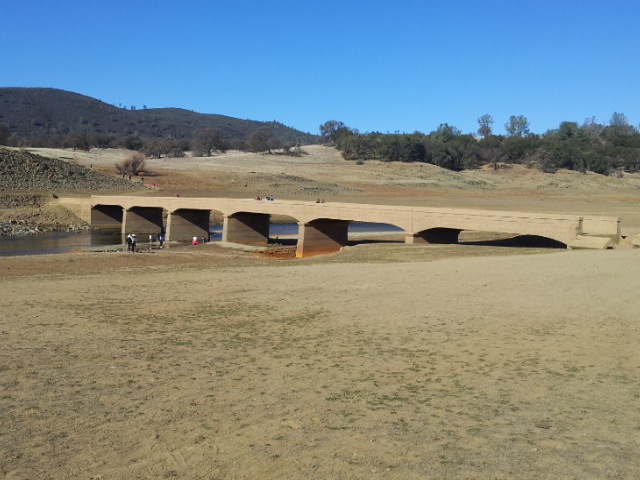- Joined
- Apr 15, 2008
- Messages
- 13,731
- Location
- California Delta
- Vessel Name
- FlyWright
- Vessel Make
- 1977 Marshall Californian 34 LRC
Unless one dives underwater, most of us spend our days enjoying life at the water's surface with occasional inadvertent encounters with the bottom. Yesterday, I had the opportunity to explore what lies below the surface due to our near record drought conditions in northern CA.
Folsom Lake normally sits at 466 ft MSL and is now sitting at below 359 ft MSL - more than 100 ft below full. This has exposed huge areas of the lake bed that have remained under water for nearly all the time since its construction in 1955.
We traveled several miles up the South Fork of the American River to access the old, normally submerged Salmon Falls Bridge. This area is normally a fairly wide channel of the lake, but has dwindled to little more than a babbling creek. I could have walked across sections and not gotten wet above my waist.
This is Salmon Falls Bridge which normally sits under 30 or more feet of water. I have boated under this bridge in my runabout in prior low-water years, but this is the first time I've been able to walk over it with dry feet. I noted a couple grooves that appeared to be propeller strikes into the concrete and stone surface.

This shot gives a bit of an idea of just how low the water level is.

It's hard to get a feel for the depth here, but this stone wall is an old reinforcement for the Old Salmon Falls Rd which normally sits under 20+ ft of water.

Next week we plan to explore exposed portions in the main body of the lake. Here's a link with pics of the ruins of Mormon Island that sit there exposed to be explored.
Folsom Lake normally sits at 466 ft MSL and is now sitting at below 359 ft MSL - more than 100 ft below full. This has exposed huge areas of the lake bed that have remained under water for nearly all the time since its construction in 1955.
We traveled several miles up the South Fork of the American River to access the old, normally submerged Salmon Falls Bridge. This area is normally a fairly wide channel of the lake, but has dwindled to little more than a babbling creek. I could have walked across sections and not gotten wet above my waist.
This is Salmon Falls Bridge which normally sits under 30 or more feet of water. I have boated under this bridge in my runabout in prior low-water years, but this is the first time I've been able to walk over it with dry feet. I noted a couple grooves that appeared to be propeller strikes into the concrete and stone surface.

This shot gives a bit of an idea of just how low the water level is.

It's hard to get a feel for the depth here, but this stone wall is an old reinforcement for the Old Salmon Falls Rd which normally sits under 20+ ft of water.

Next week we plan to explore exposed portions in the main body of the lake. Here's a link with pics of the ruins of Mormon Island that sit there exposed to be explored.

